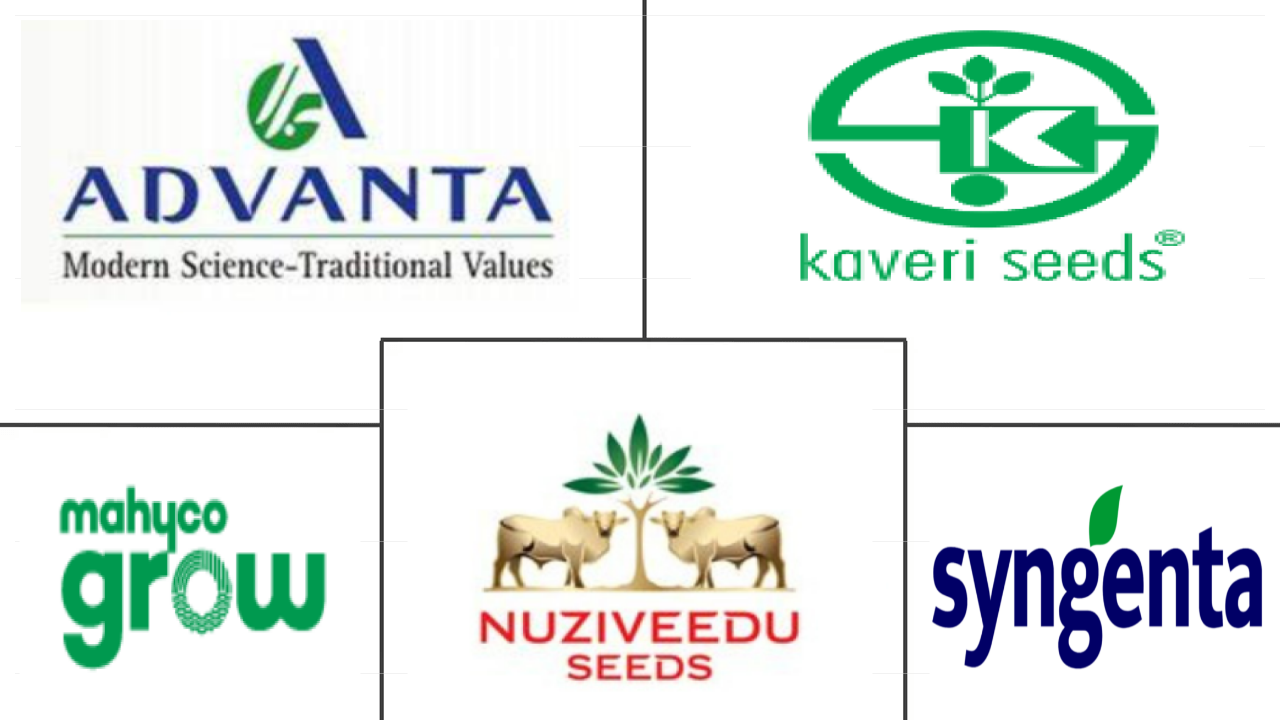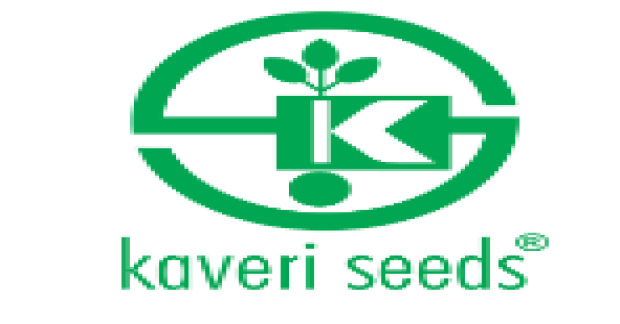India Rice Seed Market Size
| Icons | Lable | Value |
|---|---|---|
|
|
Study Period | 2017 - 2030 |
|
|
Market Size (2024) | USD 341.9 Million |
|
|
Market Size (2030) | USD 470.4 Million |
|
|
Largest Share by Breeding Technology | Open Pollinated Varieties & Hybrid Derivatives |
|
|
CAGR (2024 - 2030) | 5.46 % |
|
|
Fastest Growing by Breeding Technology | Hybrids |
|
|
Market Concentration | Low |
Major Players |
||

|
||
|
*Disclaimer: Major Players sorted in alphabetical order. |
India Rice Seed Market Analysis
The India Rice Seed Market size is estimated at 341.9 million USD in 2024, and is expected to reach 470.4 million USD by 2030, growing at a CAGR of 5.46% during the forecast period (2024-2030).
341.9 Million
Market Size in 2024 (USD)
470.4 Million
Market Size in 2030 (USD)
7.00 %
CAGR (2017-2023)
5.46 %
CAGR (2024-2030)
Largest Market by Breeding Technology
83.42 %
value share, Open Pollinated Varieties & Hybrid Derivatives, 2023
Open-pollinated varieties require fewer inputs, such as fertilizer and pesticides, are less expensive than hybrid seeds, and are more affordable for low-income farmers.
Fastest-growing Market by Breeding Technology
5.73 %
Projected CAGR, Hybrids, 2024-2030
The fastest growth of hybrids is associated with their characteristics, such as high yield and disease resistance, as well as the development and approval of transgenic hybrid varieties.
Leading Market Player1
9.13 %
market share, Kaveri Seeds, 2022

The company has a wider portfolio and has invested heavily in expansions and product innovations. Recently, it opened a new Genonmic R&D Center in Telangana, India.
Leading Market Player2
8.48 %
market share, Advanta Seeds - UPL, 2022

Advanta Seeds-UPL is the largest seed company due to the consistent development of rice since 2009, which has made it the leading rice seed manufacturer in the country.
Leading Market Player3
6.78 %
market share, Maharashtra Hybrid Seeds Co. (Mahyco), 2022

The company has emerged as a leader by developing new hybrid seeds with different traits. It has a joint venture with Monsanto Investments India Pvt. Ltd.
Higher development cost and non-availability of the hybrids are driving the demand for open-pollinated seed varieties
- In India, farmers predominantly favor open-pollinated varieties and hybrid derivatives over hybrids when it comes to rice cultivation. This preference stems from the fact that rice crops are largely self-pollinated, and the high costs associated with hybrid development have limited their widespread adoption.
- In 2022, the area under the cultivation of rice in the country was 46 million ha, an increase of 7% from 2017 due to the increasing usage of commercial seeds for high yield and product quality.
- Hybrids accounted for 16.5%, whereas OPVs accounted for 83.5% in 2022. Hybrids had a lower share than OPVs because the growers prefer to sow larger quantities of open-pollinated seed varieties as the development of hybrid seed involves higher cost and non-availability of hybrid rice seeds in the Indian market.
- Furthermore, the private sector is not performing research and development for the seed production of high-volume and low-margin crops, including rice. The public sector seed corporations are expected to remain dominant in cereals, including the rice seed segment in the country. At present, 15 state seed corporations and two national seed corporations are operating in the country.
- However, the hybrid seed segment is projected to register a CAGR of 5.7% during the forecast period due to higher productivity from the decreasing per capita availability of arable land and resistance to different diseases as well as weeds. These factors help the rice growers to earn high profits by reducing crop loss.
- The non-availability of commercial hybrid seeds in the country and preference for sowing large quantities of OPVs are expected to drive the open-pollinated seed varieties segment in the country during the forecast period.
India Rice Seed Market Trends
Various national and state-level schemes promoting rice cultivation and growing demand are driving rice cultivation in India
- India is one of the largest producers and consumers of rice globally, with an overall rice cultivation area of about 46.3 million hectares as of 2022. Indian rice cultivation area accounted for about 32.7% of the Asia-Pacific rice cultivation area in the same year. In India, rice is grown under widely varying altitudes and climate conditions. Rice cultivation in India extends from 8 to 35ºN latitude and from sea level as high as 3000 meters. The khraif season is a major rice-growing season in the country.
- In India, Uttar Pradesh, Odisha, Chattisgarh, Bihar, and Punjab are the top states in terms of total area under rice cultivation. Collectively, these states accounted for about 41.6% of the Indian rice cultivation area in 2022. Moreover, various national and state-level schemes, such as the National Food Security Mission (NFSM), actively promote rice cultivation nationwide. These schemes are anticipated to drive rice cultivation in the country during the forecast period.
- The total rice cultivation area in the country increased by about 5.2% between 2017 and 2022. This is further anticipated to increase by about 10.0% and reach 51.6 million hectares by the end of the forecast period. This increase is mainly attributed to the growing domestic demand and the export potential of rice from India. For instance, India exported 22 million metric tons of rice in 2022, worth about USD 9.6 billion.
- The growing demand for rice in both domestic and international markets and the government schemes promoting rice cultivation are the major factors anticipated to drive rice cultivation in India during the forecast period.
High demand for rice seeds with improved traits such as disease resistance, wider adaptability to different regions and climatic conditions
- In India, rice is a major crop occupying the largest area for cultivation in the country. Since the Green Revolution, a number of varieties of rice have been introduced in the country. Currently, conventional hybrids are being replaced with hybrids with advanced traits as the crop is affected by biotic stresses and different pests such as Tryporyza incertulas and Gundhi bugs. Therefore, companies are offering hybrid seeds and herbicide-tolerant transgenic seeds to growers to increase productivity and earn high profits. A major biotic constraint to rice diseases can reduce yields by 20-100%, depending on severity. Major diseases such as blast, brown spot, bacterial blight, sheath blight, and tungro viral disease cause significant damage, and new minor diseases such as false smut, grain discoloration, early seedling blight, narrow brown spot, and sheath rot have also emerged as significant problems. Various factors, including growing conditions and varietal susceptibility, can lead to losses of 1-100%.
- Major traits available in rice are disease resistance, wider adaptability to different regions and climatic conditions, tolerance to water lodging conditions, moisture stress, and drought tolerance, producing an effective and high number of tillers with extensive panicles used in cultivation. Disease-tolerant varieties are in huge demand, especially BLB (bacterial leaf blight), to increase yields. Currently, there are no effective chemicals against this pathogen, which causes up to 50% yield losses in field conditions.
- The demand for rice seeds with improved traits is increasing as farmers are turning toward sustainable agriculture. Thus, the market for seeds with improved traits is anticipated to show a positive trend during the forecast period.
OTHER KEY INDUSTRY TRENDS COVERED IN THE REPORT
- Traditional breeding dominates the market due to its ability to produce varieties with preferred characteristics such as taste, aroma, and texture
India Rice Seed Industry Overview
The India Rice Seed Market is fragmented, with the top five companies occupying 34.91%. The major players in this market are Advanta Seeds - UPL, Kaveri Seeds, Maharashtra Hybrid Seeds Co. (Mahyco), Nuziveedu Seeds Ltd and Syngenta Group (sorted alphabetically).
India Rice Seed Market Leaders
Advanta Seeds - UPL
Kaveri Seeds
Maharashtra Hybrid Seeds Co. (Mahyco)
Nuziveedu Seeds Ltd
Syngenta Group
Other important companies include Bayer AG, Corteva Agriscience, DCM Shriram Ltd (Bioseed), Rasi Seeds Private Limited, VNR Seeds.
*Disclaimer: Major Players sorted in alphabetical order.
India Rice Seed Market News
- June 2021: Bioseed, a subsidiary of DCM Shriram, launched a Bio-Innovation Center through the IRRI (International Rice Research Institute) partnership. It is a new initiative focused on research products and innovations.
- September 2020: The International Rice Research Institute (IRRI) signed a partnership agreement with hybrid seed-producing company Bioseed to develop new hybrid seed varieties of rice.
- March 2020: Corteva Agriscience launched paddy seeds under the Brevant brand for rice farmers in India. These seeds are available through selected business collaborators in a few states.
Free with this Report
We provide a complimentary and exhaustive set of data points on regional and country-level metrics that present the fundamental structure of the industry. Presented in the form of 90+ free charts, the section covers difficult-to-find data from various regions regarding the area under cultivation for different crops within the scope
India Rice Seed Market Report - Table of Contents
EXECUTIVE SUMMARY & KEY FINDINGS
REPORT OFFERS
1. INTRODUCTION
1.1. Study Assumptions & Market Definition
1.2. Scope of the Study
1.3. Research Methodology
2. KEY INDUSTRY TRENDS
2.1. Area Under Cultivation
2.2. Most Popular Traits
2.3. Breeding Techniques
2.4. Regulatory Framework
2.5. Value Chain & Distribution Channel Analysis
3. MARKET SEGMENTATION (includes market size in Value in USD, Forecasts up to 2030 and analysis of growth prospects)
3.1. Breeding Technology
3.1.1. Hybrids
3.1.1.1. Non-Transgenic Hybrids
3.1.2. Open Pollinated Varieties & Hybrid Derivatives
3.2. State
3.2.1. Andhra Pradesh
3.2.2. Assam
3.2.3. Bihar
3.2.4. Chhattisgarh
3.2.5. Odisha
3.2.6. Punjab
3.2.7. Tamil Nadu
3.2.8. Telangana
3.2.9. Uttar Pradesh
3.2.10. West Bengal
3.2.11. Other States
4. COMPETITIVE LANDSCAPE
4.1. Key Strategic Moves
4.2. Market Share Analysis
4.3. Company Landscape
4.4. Company Profiles
4.4.1. Advanta Seeds - UPL
4.4.2. Bayer AG
4.4.3. Corteva Agriscience
4.4.4. DCM Shriram Ltd (Bioseed)
4.4.5. Kaveri Seeds
4.4.6. Maharashtra Hybrid Seeds Co. (Mahyco)
4.4.7. Nuziveedu Seeds Ltd
4.4.8. Rasi Seeds Private Limited
4.4.9. Syngenta Group
4.4.10. VNR Seeds
5. KEY STRATEGIC QUESTIONS FOR SEEDS CEOS
6. APPENDIX
6.1. Global Overview
6.1.1. Overview
6.1.2. Porter’s Five Forces Framework
6.1.3. Global Value Chain Analysis
6.1.4. Global Market Size and DROs
6.2. Sources & References
6.3. List of Tables & Figures
6.4. Primary Insights
6.5. Data Pack
6.6. Glossary of Terms
List of Tables & Figures
- Figure 1:
- AREA UNDER CULTIVATION OF RICE, HECTARE, INDIA, 2017-2022
- Figure 2:
- VALUE SHARE OF MAJOR RICE TRAITS, %, INDIA, 2022
- Figure 3:
- VALUE SHARE OF RICE BREEDING TECHNIQUES, %, INDIA, 2022
- Figure 4:
- VOLUME OF RICE SEED, METRIC TON, INDIA, 2017 - 2030
- Figure 5:
- VALUE OF RICE SEED, USD, INDIA, 2017 - 2030
- Figure 6:
- VOLUME OF RICE SEED BY BREEDING TECHNOLOGY CATEGORIES, METRIC TON, INDIA, 2017 - 2030
- Figure 7:
- VALUE OF RICE SEED BY BREEDING TECHNOLOGY CATEGORIES, USD, INDIA, 2017 - 2030
- Figure 8:
- VOLUME SHARE OF RICE SEED BY BREEDING TECHNOLOGY CATEGORIES, %, INDIA, 2017 VS 2023 VS 2030
- Figure 9:
- VALUE SHARE OF RICE SEED BY BREEDING TECHNOLOGY CATEGORIES, %, INDIA, 2017 VS 2023 VS 2030
- Figure 10:
- VOLUME OF RICE SEED BY HYBRIDS CATEGORIES, METRIC TON, INDIA, 2017 - 2030
- Figure 11:
- VALUE OF RICE SEED BY HYBRIDS CATEGORIES, USD, INDIA, 2017 - 2030
- Figure 12:
- VOLUME SHARE OF RICE SEED BY HYBRIDS CATEGORIES, %, INDIA, 2017 VS 2023 VS 2030
- Figure 13:
- VALUE SHARE OF RICE SEED BY HYBRIDS CATEGORIES, %, INDIA, 2017 VS 2023 VS 2030
- Figure 14:
- VOLUME OF NON-TRANSGENIC HYBRIDS RICE SEED, METRIC TON, INDIA, 2017 - 2030
- Figure 15:
- VALUE OF NON-TRANSGENIC HYBRIDS RICE SEED, USD, INDIA, 2017 - 2030
- Figure 16:
- VALUE SHARE OF NON-TRANSGENIC HYBRIDS RICE SEED BY HYBRIDS, %, INDIA, 2023 AND 2030
- Figure 17:
- VOLUME OF OPEN POLLINATED VARIETIES & HYBRID DERIVATIVES RICE SEED, METRIC TON, INDIA, 2017 - 2030
- Figure 18:
- VALUE OF OPEN POLLINATED VARIETIES & HYBRID DERIVATIVES RICE SEED, USD, INDIA, 2017 - 2030
- Figure 19:
- VALUE SHARE OF OPEN POLLINATED VARIETIES & HYBRID DERIVATIVES RICE SEED BY BREEDING TECHNOLOGY, %, INDIA, 2023 AND 2030
- Figure 20:
- VALUE OF RICE SEED BY STATE CATEGORIES, USD, INDIA, 2017 - 2030
- Figure 21:
- VOLUME OF RICE SEED BY STATE CATEGORIES, METRIC TON, INDIA, 2017 - 2030
- Figure 22:
- VOLUME SHARE OF RICE SEED BY STATE CATEGORIES, %, INDIA, 2017 VS 2023 VS 2030
- Figure 23:
- VALUE SHARE OF RICE SEED BY STATE CATEGORIES, %, INDIA, 2017 VS 2023 VS 2030
- Figure 24:
- VOLUME OF ANDHRA PRADESH RICE SEED, METRIC TON, INDIA, 2017 - 2030
- Figure 25:
- VALUE OF ANDHRA PRADESH RICE SEED, USD, INDIA, 2017 - 2030
- Figure 26:
- VALUE SHARE OF ANDHRA PRADESH RICE SEED BY BREEDING TECHNOLOGY, %, INDIA, 2023 AND 2030
- Figure 27:
- VOLUME OF ASSAM RICE SEED, METRIC TON, INDIA, 2017 - 2030
- Figure 28:
- VALUE OF ASSAM RICE SEED, USD, INDIA, 2017 - 2030
- Figure 29:
- VALUE SHARE OF ASSAM RICE SEED BY BREEDING TECHNOLOGY, %, INDIA, 2023 AND 2030
- Figure 30:
- VOLUME OF BIHAR RICE SEED, METRIC TON, INDIA, 2017 - 2030
- Figure 31:
- VALUE OF BIHAR RICE SEED, USD, INDIA, 2017 - 2030
- Figure 32:
- VALUE SHARE OF BIHAR RICE SEED BY BREEDING TECHNOLOGY, %, INDIA, 2023 AND 2030
- Figure 33:
- VOLUME OF CHHATTISGARH RICE SEED, METRIC TON, INDIA, 2017 - 2030
- Figure 34:
- VALUE OF CHHATTISGARH RICE SEED, USD, INDIA, 2017 - 2030
- Figure 35:
- VALUE SHARE OF CHHATTISGARH RICE SEED BY BREEDING TECHNOLOGY, %, INDIA, 2023 AND 2030
- Figure 36:
- VOLUME OF ODISHA RICE SEED, METRIC TON, INDIA, 2017 - 2030
- Figure 37:
- VALUE OF ODISHA RICE SEED, USD, INDIA, 2017 - 2030
- Figure 38:
- VALUE SHARE OF ODISHA RICE SEED BY BREEDING TECHNOLOGY, %, INDIA, 2023 AND 2030
- Figure 39:
- VOLUME OF PUNJAB RICE SEED, METRIC TON, INDIA, 2017 - 2030
- Figure 40:
- VALUE OF PUNJAB RICE SEED, USD, INDIA, 2017 - 2030
- Figure 41:
- VALUE SHARE OF PUNJAB RICE SEED BY BREEDING TECHNOLOGY, %, INDIA, 2023 AND 2030
- Figure 42:
- VOLUME OF TAMIL NADU RICE SEED, METRIC TON, INDIA, 2017 - 2030
- Figure 43:
- VALUE OF TAMIL NADU RICE SEED, USD, INDIA, 2017 - 2030
- Figure 44:
- VALUE SHARE OF TAMIL NADU RICE SEED BY BREEDING TECHNOLOGY, %, INDIA, 2023 AND 2030
- Figure 45:
- VOLUME OF TELANGANA RICE SEED, METRIC TON, INDIA, 2017 - 2030
- Figure 46:
- VALUE OF TELANGANA RICE SEED, USD, INDIA, 2017 - 2030
- Figure 47:
- VALUE SHARE OF TELANGANA RICE SEED BY BREEDING TECHNOLOGY, %, INDIA, 2023 AND 2030
- Figure 48:
- VOLUME OF UTTAR PRADESH RICE SEED, METRIC TON, INDIA, 2017 - 2030
- Figure 49:
- VALUE OF UTTAR PRADESH RICE SEED, USD, INDIA, 2017 - 2030
- Figure 50:
- VALUE SHARE OF UTTAR PRADESH RICE SEED BY BREEDING TECHNOLOGY, %, INDIA, 2023 AND 2030
- Figure 51:
- VOLUME OF WEST BENGAL RICE SEED, METRIC TON, INDIA, 2017 - 2030
- Figure 52:
- VALUE OF WEST BENGAL RICE SEED, USD, INDIA, 2017 - 2030
- Figure 53:
- VALUE SHARE OF WEST BENGAL RICE SEED BY BREEDING TECHNOLOGY, %, INDIA, 2023 AND 2030
- Figure 54:
- VOLUME OF OTHER STATES RICE SEED, METRIC TON, INDIA, 2017 - 2030
- Figure 55:
- VALUE OF OTHER STATES RICE SEED, USD, INDIA, 2017 - 2030
- Figure 56:
- VALUE SHARE OF OTHER STATES RICE SEED BY BREEDING TECHNOLOGY, %, INDIA, 2023 AND 2030
- Figure 57:
- MOST ACTIVE COMPANIES BY NUMBER OF STRATEGIC MOVES, COUNT, INDIA, 2017-2023
- Figure 58:
- MOST ADOPTED STRATEGIES, COUNT, INDIA, 2017-2023
- Figure 59:
- VALUE SHARE OF MAJOR PLAYERS, %, INDIA, 2023
India Rice Seed Industry Segmentation
Hybrids, Open Pollinated Varieties & Hybrid Derivatives are covered as segments by Breeding Technology. Andhra Pradesh, Assam, Bihar, Chhattisgarh, Odisha, Punjab, Tamil Nadu, Telangana, Uttar Pradesh, West Bengal are covered as segments by State.
- In India, farmers predominantly favor open-pollinated varieties and hybrid derivatives over hybrids when it comes to rice cultivation. This preference stems from the fact that rice crops are largely self-pollinated, and the high costs associated with hybrid development have limited their widespread adoption.
- In 2022, the area under the cultivation of rice in the country was 46 million ha, an increase of 7% from 2017 due to the increasing usage of commercial seeds for high yield and product quality.
- Hybrids accounted for 16.5%, whereas OPVs accounted for 83.5% in 2022. Hybrids had a lower share than OPVs because the growers prefer to sow larger quantities of open-pollinated seed varieties as the development of hybrid seed involves higher cost and non-availability of hybrid rice seeds in the Indian market.
- Furthermore, the private sector is not performing research and development for the seed production of high-volume and low-margin crops, including rice. The public sector seed corporations are expected to remain dominant in cereals, including the rice seed segment in the country. At present, 15 state seed corporations and two national seed corporations are operating in the country.
- However, the hybrid seed segment is projected to register a CAGR of 5.7% during the forecast period due to higher productivity from the decreasing per capita availability of arable land and resistance to different diseases as well as weeds. These factors help the rice growers to earn high profits by reducing crop loss.
- The non-availability of commercial hybrid seeds in the country and preference for sowing large quantities of OPVs are expected to drive the open-pollinated seed varieties segment in the country during the forecast period.
| Breeding Technology | |||
| |||
| Open Pollinated Varieties & Hybrid Derivatives |
| State | |
| Andhra Pradesh | |
| Assam | |
| Bihar | |
| Chhattisgarh | |
| Odisha | |
| Punjab | |
| Tamil Nadu | |
| Telangana | |
| Uttar Pradesh | |
| West Bengal | |
| Other States |
Market Definition
- Commercial Seed - For the purpose of this study, only commercial seeds have been included as part of the scope. Farm-saved Seeds, which are not commercially labeled are excluded from scope, even though a minor percentage of farm-saved seeds are exchanged commercially among farmers. The scope also excludes vegetatively reproduced crops and plant parts, which may be commercially sold in the market.
- Crop Acreage - While calculating the acreage under different crops, the Gross Cropped Area has been considered. Also known as Area Harvested, according to the Food & Agricultural Organization (FAO), this includes the total area cultivated under a particular crop across seasons.
- Seed Replacement Rate - Seed Replacement Rate is the percentage of area sown out of the total area of crop planted in the season by using certified/quality seeds other than the farm-saved seed.
- Protected Cultivation - The report defines protected cultivation as the process of growing crops in a controlled environment. This includes greenhouses, glasshouses, hydroponics, aeroponics, or any other cultivation system that protects the crop against any abiotic stress. However, cultivation in an open field using plastic mulch is excluded from this definition and is included under open field.
| Keyword | Definition |
|---|---|
| Row Crops | These are usually the field crops which include the different crop categories like grains & cereals, oilseeds, fiber crops like cotton, pulses, and forage crops. |
| Solanaceae | These are the family of flowering plants which includes tomato, chili, eggplants, and other crops. |
| Cucurbits | It represents a gourd family consisting of about 965 species in around 95 genera. The major crops considered for this study include Cucumber & Gherkin, Pumpkin and squash, and other crops. |
| Brassicas | It is a genus of plants in the cabbage and mustard family. It includes crops such as carrots, cabbage, cauliflower & broccoli. |
| Roots & Bulbs | The roots and bulbs segment includes onion, garlic, potato, and other crops. |
| Unclassified Vegetables | This segment in the report includes the crops which don’t belong to any of the above-mentioned categories. These include crops such as okra, asparagus, lettuce, peas, spinach, and others. |
| Hybrid Seed | It is the first generation of the seed produced by controlling cross-pollination and by combining two or more varieties, or species. |
| Transgenic Seed | It is a seed that is genetically modified to contain certain desirable input and/or output traits. |
| Non-Transgenic Seed | The seed produced through cross-pollination without any genetic modification. |
| Open-Pollinated Varieties & Hybrid Derivatives | Open-pollinated varieties produce seeds true to type as they cross-pollinate only with other plants of the same variety. |
| Other Solanaceae | The crops considered under other Solanaceae include bell peppers and other different peppers based on the locality of the respective countries. |
| Other Brassicaceae | The crops considered under other brassicas include radishes, turnips, Brussels sprouts, and kale. |
| Other Roots & Bulbs | The crops considered under other roots & bulbs include Sweet Potatoes and cassava. |
| Other Cucurbits | The crops considered under other cucurbits include gourds (bottle gourd, bitter gourd, ridge gourd, Snake gourd, and others). |
| Other Grains & Cereals | The crops considered under other grains & cereals include Barley, Buck Wheat, Canary Seed, Triticale, Oats, Millets, and Rye. |
| Other Fibre Crops | The crops considered under other fibers include Hemp, Jute, Agave fibers, Flax, Kenaf, Ramie, Abaca, Sisal, and Kapok. |
| Other Oilseeds | The crops considered under other oilseeds include Ground nut, Hempseed, Mustard seed, Castor seeds, safflower seeds, Sesame seeds, and Linseeds. |
| Other Forage Crops | The crops considered under other forages include Napier grass, Oat grass, White clover, Ryegrass, and Timothy. Other forage crops were considered based on the locality of the respective countries. |
| Pulses | Pigeon peas, Lentils, Broad and horse beans, Vetches, Chickpeas, Cowpeas, Lupins, and Bambara beans are the crops considered under pulses. |
| Other Unclassified Vegetables | The crops considered under other unclassified vegetables include Artichokes, Cassava Leaves, Leeks, Chicory, and String beans. |
Research Methodology
����vlog��ý follows a four-step methodology in all our reports.
- Step-1: IDENTIFY KEY VARIABLES: In order to build a robust forecasting methodology, the variables and factors identified in Step-1 are tested against available historical market numbers. Through an iterative process, the variables required for market forecast are set and the model is built on the basis of these variables.
- Step-2: Build a Market Model: Market-size estimations for the forecast years are in nominal terms. Inflation is not a part of the pricing, and the average selling price (ASP) is kept constant throughout the forecast period.
- Step-3: Validate and Finalize: In this important step, all market numbers, variables and analyst calls are validated through an extensive network of primary research experts from the market studied. The respondents are selected across levels and functions to generate a holistic picture of the market studied.
- Step-4: Research Outputs: Syndicated Reports, Custom Consulting Assignments, Databases, and Subscription Platforms








